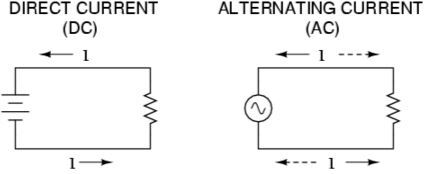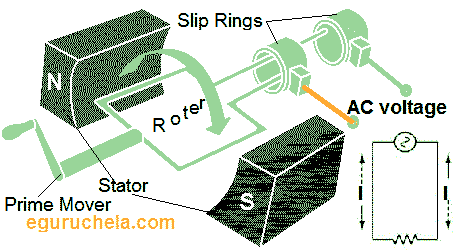AC Generator
An AC generator produces electricity from a coil that rotates with respect to a powerful magnetic field. Whenever an electrical conductor moves in a magnetic field, electric current arises in that conductor.
A generator can comprise a rotating magnet inside a fixed coil of wire, or a rotating coil inside a fixed magnet or set of magnets.
A mechanical force drives the rotating magnet or coil shaft.

Such force can originate from falling or flowing water, prevailing winds, ocean currents, nuclear reactions, heat from inside the earth, steam under pressure, or explosive combustion of fossil fuels.
This type of generator always produces AC directly.
A machine that converts mechanical power into alternating current electric power. Almost all electric power is produced by alternating-current (ac) generators that are driven by rotating prime movers.
Most of the prime movers are steam turbines whose thermal energy comes from steam generators that use either fossil or nuclear fuel.
Combustion turbines are oftenused for the smaller units and in cases where gas or oil is the available fuel.
Where water power is available from dams, hydroelectric ac generators are powered by hydraulic turbines.
Small sites may also use diesel or gasoline engines to drive the generator, but these units are usually used only for standby generation or to provide electric power in remote areas.
Components of an AC generator

Armature
Stator
Field
Prime Mover
Rotor
Slip Rings
Armature
The armature is a power generating component in which the voltage is produced.
The armature consists of coils of wire that are large enough to carry the full-load current of the generator.
Stator
The stator comprises of the non-rotating component of ac generator and the stator core comprises a lamination of steel alloys or magnetic iron to minimise the eddy current losses.
The stator converts the rotating magnetic field to electric current.
Field
The field consists of coils of conductors that receive a voltage from the source and produce magnetic flux.
The magnetic flux in the field cuts the armature to produce the voltage which is known as output voltage of AC generator.
Prime Mover
The prime mover drives the rotor and prime mover could either be a manual-device, diesel engine, steam turbine or motor.
Rotor
This is the rotating component of AC generator. The prime mover drives the rotor.
Slip Rings
Slip rings are designed to conduct the flow of current from a stationary device to a rotating one.
Slip rings are electrical connections helps to transfer power to-and-fro from rotor.
Advantages of AC Generators over DC generators
AC generators can be stepped up and stepped down through transformers very easily.
Because of the step-up feature transmission link size might be thinner and .
Size of the AC generators are relatively small as campare to DC generators.
Disadvantages of AC generators
When it comes to handling this becomes a challenge due to the high voltage required to supply a certain level of power.
These systems require additional insulation due to the greater voltage required to supply a certain level of power.
